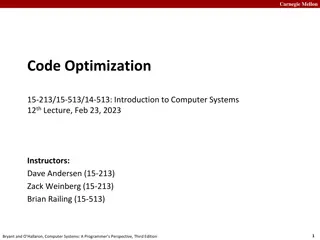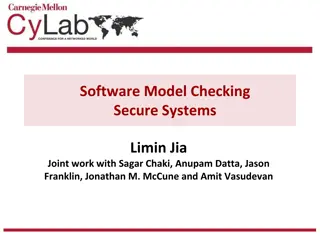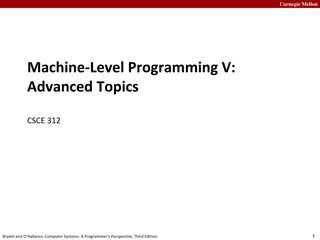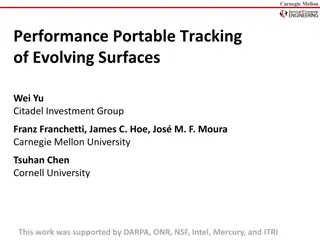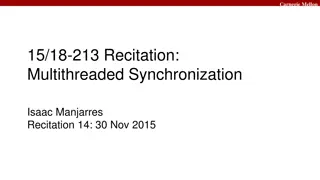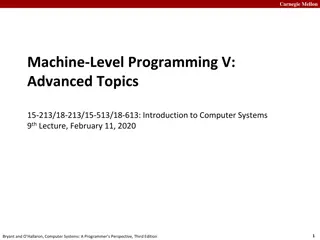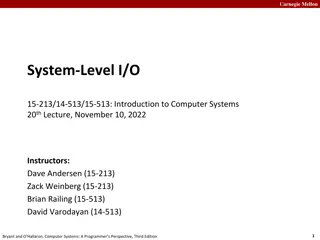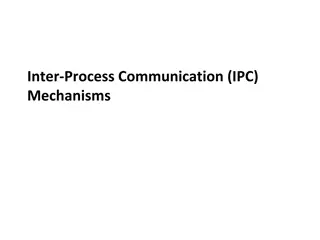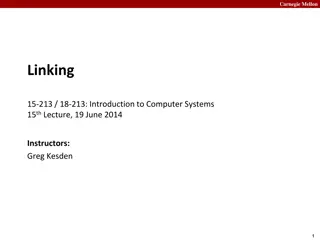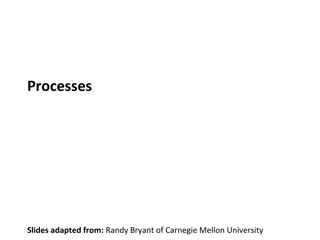Understanding Memory Management Concepts at Carnegie Mellon University
Explore advanced topics in memory management as taught at Carnegie Mellon University, including dynamic memory allocation, heap structure visualization, and common programming challenges related to memory utilization and throughput. The content covers practical insights and solutions for optimizing memory usage and addressing memory-related issues in programming.
- Memory Management
- Carnegie Mellon University
- Dynamic Allocation
- Heap Structure
- Programming Challenges
Download Presentation

Please find below an Image/Link to download the presentation.
The content on the website is provided AS IS for your information and personal use only. It may not be sold, licensed, or shared on other websites without obtaining consent from the author. Download presentation by click this link. If you encounter any issues during the download, it is possible that the publisher has removed the file from their server.
E N D
Presentation Transcript
Carnegie Mellon Recitation 11: More Malloc Lab Instructor: TA(s) 1 Bryant and O Hallaron, Computer Systems: A Programmer s Perspective, Third Edition
Carnegie Mellon Understanding Your Code Sketch out the heap Add Instrumentation Use tools 2 Bryant and O Hallaron, Computer Systems: A Programmer s Perspective, Third Edition
Carnegie Mellon Sketch out the Heap Start with a heap, in this case implicit list 0 4 0 0 4 4 4 4 6 6 4 Now try something, in this case, extend_heap block_t *block = payload_to_header(bp); write_header(block, size, false); write_footer(block, size, false); // Create new epilogue header block_t *block_next = find_next(block); write_header(block_next, 0, true); 3 Bryant and O Hallaron, Computer Systems: A Programmer s Perspective, Third Edition
Carnegie Mellon Sketch out the Heap Here is a free block based on lectures 19 and 20 Explicit pointers (will be well-defined see writeup and Piazza) This applies to ALL new fields you want inside your struct Optional boundary tags 1 word Size b0 If you make changes to your design beyond this Draw it out. If you have bugs, pictures can help the staff help you Put a picture of your data structure into your file header (optional, but we will be impressed) Next Prev Unallocated Size b0 Free Block 4 Bryant and O Hallaron, Computer Systems: A Programmer s Perspective, Third Edition
Carnegie Mellon Common Problems Throughput is very low Which operation is likely the most throughput intensive? Hint: It uses loops! Solution: ?? 5 Bryant and O Hallaron, Computer Systems: A Programmer s Perspective, Third Edition
Carnegie Mellon Common Problems Throughput is very low Which operation is likely the most throughput intensive? Hint: It uses loops! Solution: Instrument your code! Utilization is very low / Out of Memory Which operation can cause you to allocate more memory than you may need? Hint: It extends the amount of memory that you have! Solution: ?? 6 Bryant and O Hallaron, Computer Systems: A Programmer s Perspective, Third Edition
Carnegie Mellon Common Problems Throughput is very low Which operation is likely the most throughput intensive? Hint: It uses loops! Solution: Instrument your code! Utilization is very low / Out of Memory Which operation can cause you to allocate more memory than you may need? Hint: It extends the amount of memory that you have! Solution: Instrument your code! 7 Bryant and O Hallaron, Computer Systems: A Programmer s Perspective, Third Edition
Carnegie Mellon Add Instrumentation Remember that measurements inform insights. Add temporary code to understand aspects of malloc Code can violate style rules or 128 byte limits, because it is temporary Particularly important to develop insights into performance before making changes What is expensive throughput-wise? How much might a change benefit utilization? 8 Bryant and O Hallaron, Computer Systems: A Programmer s Perspective, Third Edition
Carnegie Mellon Add Instrumentation example Searching in find_fit is often the slowest step How efficient is your code? How might you know? Compute the ratio of blocks viewed to calls static block_t *find_fit(size_t asize) { block_t *block; for (block = heap_listp; get_size(block) > 0; block = find_next(block)) { if (!(get_alloc(block)) && (asize <= get_size(block))) { return block; } } return NULL; // no fit found call_count++; block_count++; Bryant and O Hallaron, Computer Systems: A Programmer s Perspective, Third Edition } 9
Carnegie Mellon Add Instrumentation cont. What size of requests? How many 8 bytes or less? How many 16 bytes or less? What other sizes? What else could you measure? Why? Remember that although the system s performance varies The mdriver s traces are deterministic Measured results should not change between runs 10 Bryant and O Hallaron, Computer Systems: A Programmer s Perspective, Third Edition
Carnegie Mellon Use tools Use mm_checkheap() Write it if you haven t done so already Add new invariants when you add new features Know how to use the heap checker. Why do you need a heap checker? 2 reasons. Use gdb You can call print or mm_checkheap whenever you want in gdb. No need to add a while lot of printf s. Offers useful information whenever you crash, like backtrace. Write helper functions to print out free lists that are ONLY called from GDB 11 Bryant and O Hallaron, Computer Systems: A Programmer s Perspective, Third Edition
Carnegie Mellon mdriver-emulate Testing for 64-bit address space Use correctly sized masks, constants, and other variables Be careful about subtraction between size types (may re result in underflow/overflow) Reinitialize your pointers in mm_init 12 Bryant and O Hallaron, Computer Systems: A Programmer s Perspective, Third Edition
Carnegie Mellon Garbled Bytes Malloc library returns a block mdriver writes bytes into payload (using memcpy) mdriver will check that those bytes are still present If malloc library has overwritten any bytes, then report garbled bytes Also checks for other kinds of bugs Now what? The mm_checkheap call is catching it right? If not, we want to find the garbled address and watch it 13 Bryant and O Hallaron, Computer Systems: A Programmer s Perspective, Third Edition
Carnegie Mellon Garbled Bytes and gdb Get out a laptop Login to shark machine wget http://www.cs.cmu.edu/~213/activities/rec11b.tar tar xf rec11b.tar mm.c is a fake explicit list implementation. Source code is based on mm_baseline.c A few lines of code are added that vaguely resembles what an explicit list implementation could have. 14 Bryant and O Hallaron, Computer Systems: A Programmer s Perspective, Third Edition
Carnegie Mellon GDB Exercise gdb --args ./mdriver -c ./traces/syn-array-short.rep -D (gdb) r // Sample output follows Throughput targets: min=6528, max=11750, benchmark=13056 Malloc size 9904 on address 0x800000010. ... ERROR [trace ././traces/syn-array-short.rep, line 12]: block 0 has 8 garbled bytes, starting at byte 0 ... Terminated with 2 errors [Inferior 1 (process 13470) exited normally] (gdb) 15 Bryant and O Hallaron, Computer Systems: A Programmer s Perspective, Third Edition
Carnegie Mellon GDB Exercise cont. What is the first address that was garbled? Use gdb watch to find out when / what garbled it. (gdb) watch * 0x800000010 (gdb) run // Keep continuing through the breaks: // mm_init() // 4 x memcpy Hardware watchpoint 1: *0x800000010 We just broke in after overwriting Old value = -7350814 New value = 9928 mm_malloc (size=50084) at mm.c:214 16 Bryant and O Hallaron, Computer Systems: A Programmer s Perspective, Third Edition
Carnegie Mellon Second Exercise Well fine, the bug from the first exercise was very artificial. No one just sets bytes to 0 for no reason. Try this more plausible exercise: $ gdb --args ./mdriver-2 -c traces/syn-array-short.rep What error was printed to the console? The function that prints the error is named malloc_error. Add a breakpoint for it if you want. 17 Bryant and O Hallaron, Computer Systems: A Programmer s Perspective, Third Edition
Carnegie Mellon Second Exercise The library must ve written the header and footer for the out-of-bounds payload at some point. Add a watchpoint for either address, or both. (gdb) watch * 0x8000036c8 (gdb) run So, the writes occurred in place. Is the place function wrong, or was it just given a bad argument? Hint: the bug is found in at basically the same place as last recitation s bug. It s caused by a careless typo, like nearly all others bugs. 18 Bryant and O Hallaron, Computer Systems: A Programmer s Perspective, Third Edition
Carnegie Mellon Tips for using our tools Run mdriver with the D option to detect garbled bytes as early as possible. Run it with V to find out which trace caused the error. Note that sometimes, you get the error within the first few allocations. If so, you could set a breakpoint for mm_malloc / mm_free and step though every line. Print out local variables and convince yourself that they have the right values. For mdriver-emulate, you can still read memory from the simulated 64-bit address space using mem_read(address, 8) instead of x /gx. 19 Bryant and O Hallaron, Computer Systems: A Programmer s Perspective, Third Edition
Carnegie Mellon MallocLab Due Thursday 7% of final grade (+ 4% for checkpoint) Style matters! Don t let all of your hard work get wasted. There are many different implementations and TAs will need to know the details behind your implementation. Read the writeup. It even has a list of tips on how to improve memory utilization. Rubber duck method If you explain to a rubber duck / TA what your function does step- by-step, while occasionally stopping to explain why you need each of those steps, you d may very well find the bug in the middle of your explanation. Remember the debug thought process slide from Recitation 10? 20 Bryant and O Hallaron, Computer Systems: A Programmer s Perspective, Third Edition
Carnegie Mellon Style Well organized code is easier to debug and easier to grade! Modularity: Helper functions to respect the list interface. Documentation: File Header: Describes all implementation details, including block structures. Checkheap: Describes all checks implemented. Code Structure: Minimal-to-no pointer arithmetic. Loops instead of conditionals, where appropriate. 21 Bryant and O Hallaron, Computer Systems: A Programmer s Perspective, Third Edition





